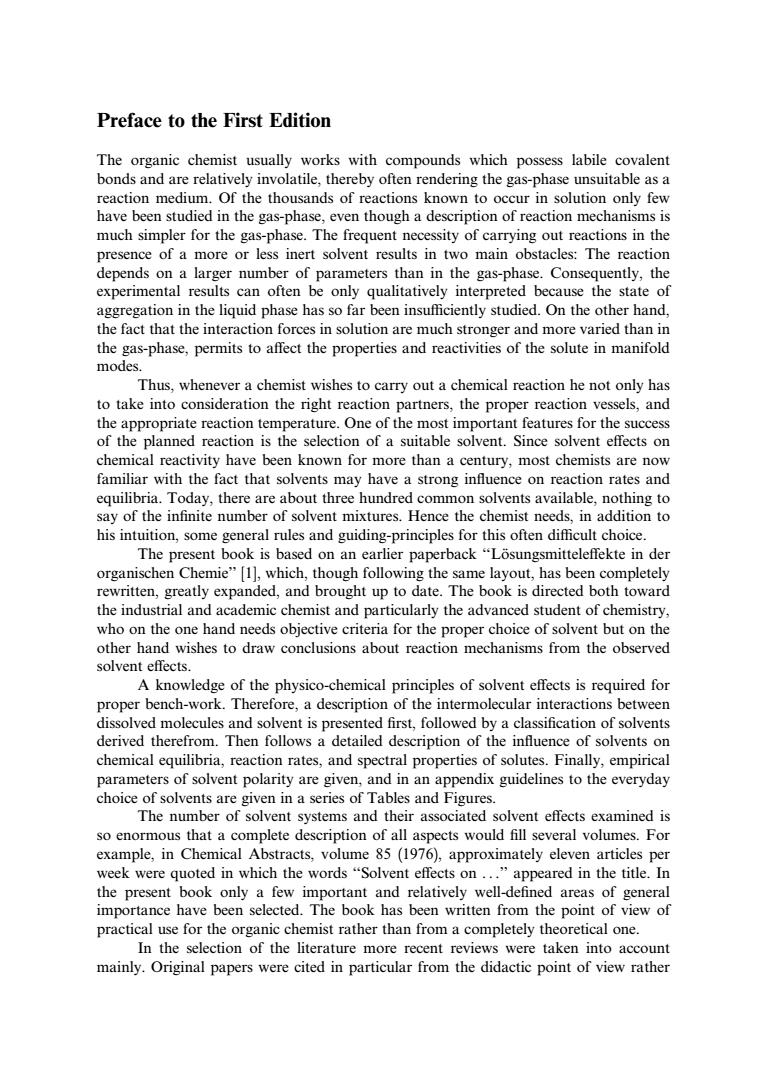正在加载图片...

Preface to the First Edition The organic chemist usually works with compounds which possess labile covalent bonds and are relatively involatile,thereby often rendering the gas-phase unsuitable as a reaction medium.Of the thousands of reactions known to occur in solution only few have been studied in the gas-phase,even though a description of reaction mechanisms is much simpler for the gas-phase.The frequent necessity of carrying out reactions in the presence of a more or less inert solvent results in two main obstacles:The reaction depends on a larger number of parameters than in the gas-phase.Consequently,the experimental results can often be only qualitatively interpreted because the state of aggregation in the liquid phase has so far been insufficiently studied.On the other hand, the fact that the interaction forces in solution are much stronger and more varied than in the gas-phase,permits to affect the properties and reactivities of the solute in manifold modes. Thus.whenever a chemist wishes to carry out a chemical reaction he not only has to take into consideration the right reaction partners.the proper reaction vessels.and ooetst o chemical reactivity have been known for more than a century.most chemists are now familiar with the fact that solvents may have a strong influence on reaction rates and quilibria Today there are about three hundred cor his intuition.some g neral rules and guiding-principles for this often difficult choice The present book is b sed on an earlier erback"Losungsmitteleftekte in der Che which though follo t has hee ded and bro ught up to date.The boc k is dire ted hoth oward the industrial and ad ade ic chemist and ticularly the ced student of chemist yho on the ne hand ne for the solvent but on th hes to dra eac the olvent eftects ve wledge of the pny ical principles of solve cts is requ ired for prope ork Th ent is pre a clas ical equ cription solven vent polarity are giver y,empi n an ines to t e everyday are g nt effects examined is piete des would 85 (1976),approximately e rticl spe in which the words 'Solvent effects on appeared in the title. he pres only a lew mportant and relatively well-define d areas of genera mportance have been selected.The book has been written from the point of view of practical use for the organic chemist rather than from a completely theoretical one In the selection of the literature more recent reviews were taken into account mainly.Original papers were cited in particular from the didactic point of view ratherPreface to the First Edition The organic chemist usually works with compounds which possess labile covalent bonds and are relatively involatile, thereby often rendering the gas-phase unsuitable as a reaction medium. Of the thousands of reactions known to occur in solution only few have been studied in the gas-phase, even though a description of reaction mechanisms is much simpler for the gas-phase. The frequent necessity of carrying out reactions in the presence of a more or less inert solvent results in two main obstacles: The reaction depends on a larger number of parameters than in the gas-phase. Consequently, the experimental results can often be only qualitatively interpreted because the state of aggregation in the liquid phase has so far been insu‰ciently studied. On the other hand, the fact that the interaction forces in solution are much stronger and more varied than in the gas-phase, permits to a¤ect the properties and reactivities of the solute in manifold modes. Thus, whenever a chemist wishes to carry out a chemical reaction he not only has to take into consideration the right reaction partners, the proper reaction vessels, and the appropriate reaction temperature. One of the most important features for the success of the planned reaction is the selection of a suitable solvent. Since solvent e¤ects on chemical reactivity have been known for more than a century, most chemists are now familiar with the fact that solvents may have a strong influence on reaction rates and equilibria. Today, there are about three hundred common solvents available, nothing to say of the infinite number of solvent mixtures. Hence the chemist needs, in addition to his intuition, some general rules and guiding-principles for this often di‰cult choice. The present book is based on an earlier paperback ‘‘Lo¨sungsmittele¤ekte in der organischen Chemie’’ [1], which, though following the same layout, has been completely rewritten, greatly expanded, and brought up to date. The book is directed both toward the industrial and academic chemist and particularly the advanced student of chemistry, who on the one hand needs objective criteria for the proper choice of solvent but on the other hand wishes to draw conclusions about reaction mechanisms from the observed solvent e¤ects. A knowledge of the physico-chemical principles of solvent e¤ects is required for proper bench-work. Therefore, a description of the intermolecular interactions between dissolved molecules and solvent is presented first, followed by a classification of solvents derived therefrom. Then follows a detailed description of the influence of solvents on chemical equilibria, reaction rates, and spectral properties of solutes. Finally, empirical parameters of solvent polarity are given, and in an appendix guidelines to the everyday choice of solvents are given in a series of Tables and Figures. The number of solvent systems and their associated solvent e¤ects examined is so enormous that a complete description of all aspects would fill several volumes. For example, in Chemical Abstracts, volume 85 (1976), approximately eleven articles per week were quoted in which the words ‘‘Solvent e¤ects on . . .’’ appeared in the title. In the present book only a few important and relatively well-defined areas of general importance have been selected. The book has been written from the point of view of practical use for the organic chemist rather than from a completely theoretical one. In the selection of the literature more recent reviews were taken into account mainly. Original papers were cited in particular from the didactic point of view rather